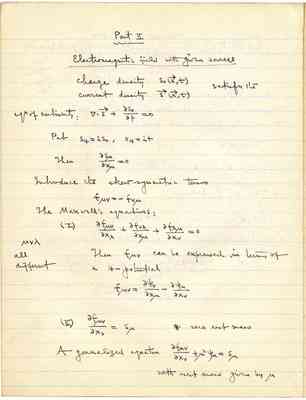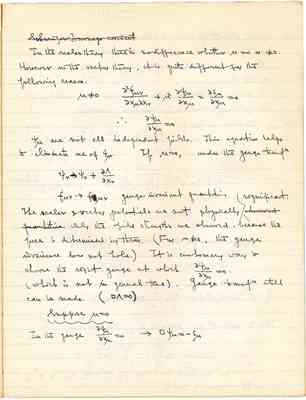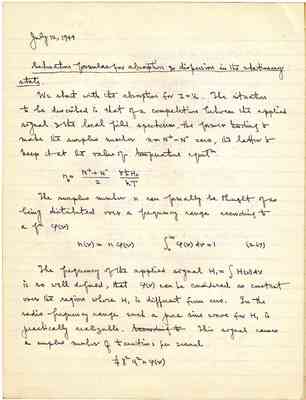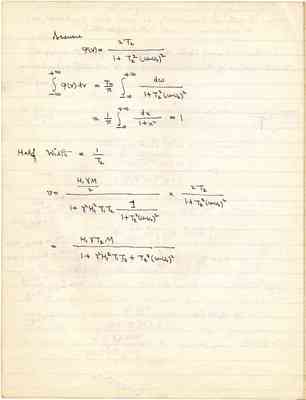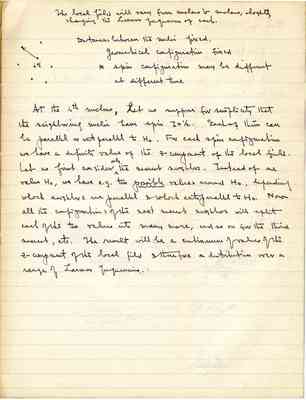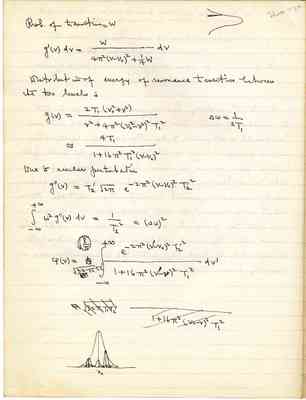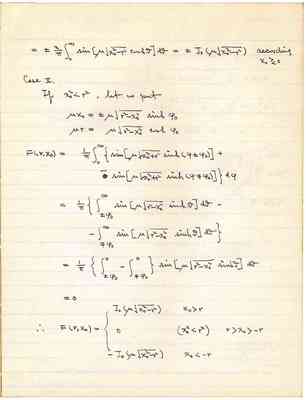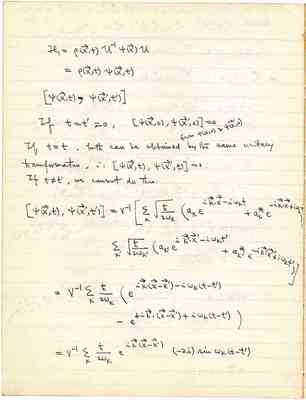Pages That Need Review
Research Notes II, 1949
59
Part II
Electromagnetic field with given sources
Charge density Current density satisfy the
eqn of continuity:
Put
Then
Introduce the skew symmetric tensor The Maxwell's equations: μνλ all different (I)
Then fμν can be expressed in terms of a 4-potential
(II) zero net mass
A generalized equation with rest mass given by μ
60
[Schweizer?]-Tomonago covariant
In the scalar theory there is no difference whether μ=0 or ≠0. However with vector theory, [?] is quite different for the following reason.
Ψμ are not all independent fields. This equation helps to eliminate one of Ψμ. If μ=0, under the gauge transf[n?]
gauge-invariant quantities
The scalar & vector potentials are not physically observed qualities. Only the field strengths are observed, significant because the force is determined by them. (For μ≠0, the gauge invariante does not hold.) It is customary way to choose the right gauge at which . (which is not in general true). Gauge transfn [?] can be made.
Suppose μ=0
In the gauge
28
July 12, 1949
Saturation formulas for absorption & dispersion in the stationary state
We start with the absorption for I=1/2. The situation to be described is that of a competition between the applied signal & the local field spectrum, the former tending to make the surplus number zero, the latter to keep it at the value of temperature equilm.
The surplus number n can formally be thought of as being distributed over a frequency range according to a fn φ(ν)
The frequency of the applied signal {tex: $H_1 = \int H(\nu)d\nu :tex}} is so well defined, that φ(ν) can be considered as constant over the region where H₁ is different from zero. In the radio frequency range such a pure sine wave for H₁ is practically realizable. According to This signal causes a surplus number of transitions per second
31
The local field will vary from nuclues to nucleus, slightly changing the Larmor frequencies of each.
[Diagram of 6 dots arrranged in a circle with one dot in the center labeled ith. An arrow is drawn from the central dot to the dot to its upper left.] Distances between the nuclei fixed. Geometrical configuration fixed * spin configuration may be different at different time.
At the ith nucleus, let us suppose for simplicity that the neighboring nuclei have spin I = 1/2. Each of them can be parallel or antiparallel to H0. For each spin configuration we have a definite value of the z-component of the local field. Let us first consider only the nearest neighbors. Instead of one value H0, we have e.g. ten possible values around H0, depending which neighbors are parallel & which antiparallel to H0. Now all the configurations of the next nearest neighbors will split each of the ten values into many more, and so on for the third nearest, etc. The result will be a continuum of values of the z-component of the local field & therefore a distribution over a range of Larmor frequencies.
42
Rest mass of particle m = ħμ. = energy of particle.
no zero pt. momentum.
We must assume the source for ρ has the same periodicity as the field.
describing the emission & absorption processes.
The Schrödinger equation
All the other representations can be obtained from the one already obtained by unitary ħ and fn:

